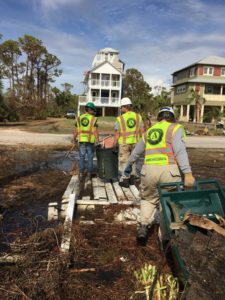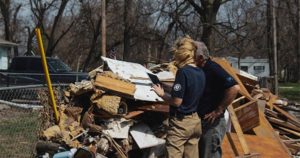In mid-December, late-season tornadoes produced catastrophic damage and numerous fatalities across five states. The National Weather Service recorded more than 40 tornadoes, including eight in Kentucky, resulting in more than 90 deaths. The governors of Kentucky, Tennessee, and Arkansas declared States of Emergency and FEMA approved Major Federal Declarations for Kentucky and Emergency Declarations for Tennessee and Illinois. The long-term efforts to rebuild these communities won’t take days or weeks. It will take years.
Since the tornados first hit, we have witnessed the very best of the American spirit, with neighbor helping neighbor and friend helping friend. First responders, state, regional, and federal emergency partners, nonprofit organizations, and private companies all joining the effort to help one another. As with hundreds of our nation’s former disasters, AmeriCorps has played a pivotal role. Immediately after the storm hit, AmeriCorps St. Louis was activated by local emergency management to stand up a Volunteer Reception Center. One day later, they were on the ground in Defiance, Missouri training and deploying over 150 volunteers. AmeriCorps members joined Team Rubicon, a nonprofit group that uses military veterans and first responders to quickly deploy emergency response teams to disaster areas across the country, to help with the cleanup in Kentucky; they remain there today. And Serve Kentucky deployed AmeriCorps members to register tornado survivors, distribute donations, and assist with requests for food.
These are just a few examples of how AmeriCorps members are helping with response and recovery. It’s a role AmeriCorps knows well. Take 2020 for example, when AmeriCorps (the federal agency that engages Americans in service) responded to the summer wildfires in California, Colorado, Oregon and Washington, the Derecho windstorm in Iowa, Hurricane Laura in Louisiana and Texas, and, most notably, the COVID-19 pandemic – a priority that continues today.

Since 1994, AmeriCorps programs have responded to forest fires, floods, hurricanes, tornadoes, terror attacks, pandemics, and oil spills, providing critical supports to millions of Americans. This is what AmeriCorps is best at and what makes it unique. AmeriCorps members create the infrastructure for large scale volunteer management and provide expert manpower, everything from volunteer coordination to donations management, sandbagging to shelter operations, and debris removal to home repairs. Often AmeriCorps arrives as early as day one and does not leave until the hard work of rebuilding is complete, sometimes years later.
AmeriCorps is a respected partner in the federal disaster space. In 2017, the National Voluntary Organizations Active in Disasters (NVOAD) selected AmeriCorps as the National VOAD Partner of the Year, recognizing the contributions the program has had in disaster response and recovery efforts throughout the country. Members of Congress, Governors, and mayors also know that AmeriCorps plays an outsized role in the immediate- and long-term recovery. Having governed Mississippi in the wake of Hurricane Katrina, Governor Haley Barbour has said, “I know what the hardworking taxpayers think about AmeriCorps…These young men and women were the glue that bound together our entire volunteer operation. They ran our shelters and feeding centers, our donation warehouses and emergency call centers. They built or repaired more than 15,000 homes, completed thousands of damage assessments and supported emergency response centers throughout the Gulf Coast region. Crucially, they provided training that enabled volunteers to effectively clean up communities in the wake of the most expensive storm in American history…I hope America never endures another storm as devastating as Hurricane Katrina. Should we, I pray AmeriCorps members will be there.”
National service programs harness the energy and ingenuity of our nation’s most valuable resource – our citizens – to address community needs and help local economies grow. In addition to disaster services, national service enables thousands of community and faith-based organizations, including the American Red Cross, Habitat for Humanity, the Boys and Girls Clubs of America, and Teach for America, to put boots on the ground to strengthen education from preschool through college, support our veterans and military families, combat poverty, assist seniors in independent living, and foster economic opportunities across America.

The economic value of this work is enormous. According to a 2020 study, every $1 in federal money invested in national service programs returns $17.30 to society, program members, and the federal government. That means with an annual budget of $1.12 billion, the AmeriCorps programs yield more than $19.3 billion in higher earnings, higher tax revenues, and lower strain on the social safety net every year.
Furthermore, AmeriCorps is a proven pathway that helps young people prepare for future jobs, particularly for populations hardest hit by the pandemic. Members gain valuable career skills and experience, from career training to occupational skills and network building. According to a survey of AmeriCorps alumni, eight out of ten say AmeriCorps advanced and benefited their career path.
As 2022 gets underway, we know that AmeriCorps will continue to play a key role in disaster assistance, whether it be in response to natural disasters or the ongoing COVID-19 pandemic. Given the scale of need, now is the time to expand and strengthen national service to get more boots on the ground in our communities.